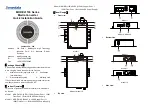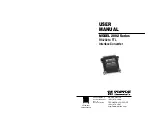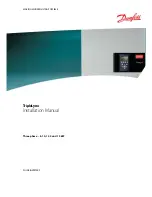
— 37 —
event will be placed in residence in encoder memory –
all other
scheduled events will be lost!
Priority of
Scheduled
Events
Scheduled events always have priority over scrolling messages
and other commands incoming to the 730 Encoder. When a
scheduled event’s time comes, it takes over the encoder, and
contrary incoming commands of like kind are ignored for the
programmed Duration period. To cancel a scheduled event, the
Scheduler must be disabled, either from the front panel on
Menu 75 or by unchecking the
Enable
box in the software in-
terface and then clicking the
WRITE
button with the
Update
Scheduler on Next Read/Write
box checked. The schedule field
may then be edited, the scheduler re-enabled, and these
changes uploaded to the 730 Encoder by clicking the
WRITE
button again.
‘Open-Ended’
Events
If a Duration value of 0 (zero) for an event is entered into the
Scheduler, the scheduled text will begin scrolling at the speci-
fied time, and will continue to scroll indefinitely until a con-
trary command (scrolling message or [header]=X) is uploaded
to the 730 Encoder. Only when Duration is zero will an incom-
ing command have priority over the scheduled event.
An example of the usefulness of zero-duration might be that
Little League baseball game shown in the example schedule on
Page 35. Game duration in that instance was fixed at 90 mi-
nutes by arrangement with the team and advertisers. A less
formal schedule, with a 0 in the Duration column, would have
allowed normal programming with its attendant scrolling mes-
sage to commence at the end of the game.
DAYLIGHT SAVING TIME
Until fairly recently, Daylight Saving Time (DST) was less com-
plex than it has now become. Different locales adopt DST on
dates that change at the whim of government bureaucrats, as
exemplified in the rules for the US and Europe reproduced here:
The real-time clock in the 730 Encoder is kept accurate auto-
matically when the unit is connected to the Internet, or it may
be set manually through the software interface or with the jog
wheel on Menu 58. In any case, the time shown on Menu 58 is
local time and must take both the offset with UTC (Universal
Coordinated time) and DST (Daylight Saving Time) into account.
Clicking:
Tools/Daylight Saving
brings down the DST scheduling
box. This is shown on the next page, filled-in for the next ten
years according to current DST observance in the US. Note the
valuable button at the top:
Let Windows do the Work!
Clicking
this button will automatically program the DST Start and End















































